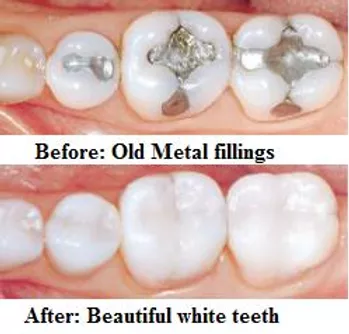A composite filling is a tooth-coloured resin and glass mixture used to restore decayed or broken teeth. By using enamel and dentin bonding techniques, white fillings restore teeth that have become damaged as a result of tooth decay or injury. White fillings are used as an alternative to amalgam (silver) fillings, which are aesthetically poor and contain mercury.
After removing plaque, tartar, decay and any existing filling, the treatment site is cleaned and then dried. To aid the bonding, the tooth surface is etched and coated with a gel and bonding solution. Once prepared, the white filling material is placed into the tooth cavity, or area to be filled, and then moulded to match the tooth contours. A curing light is then used to harden the filling before it is trimmed and polished to look like a natural part of your tooth.
There are two types of white filling – direct and indirect – and they are based on when the light is used during the curing procedure. Direct white fillings or dental composites are hardened with a curing light after the white filling material is used to fill the cavity and moulded to match the tooth’s shape. This direct procedure is used for dental treatments such as disguising gaps, tooth-reshaping and fillings. In the indirect procedure, the white filling material is first cured with light in a lab before it is placed within the mouth. This method is used more frequently for larger tooth cavities, reshaping, inlays and onlays, and partial crowns.
Inherent risks exist in all dental procedures, but the main concern with white fillings is their durability and potential shrinkage. However, new technology and dental procedures are resulting in stronger, longer-lasting and lower-shrinkage white fillings.
The benefits far outweigh such problems, because white fillings:




| Cookie | Duration | Description |
|---|---|---|
| cookielawinfo-checkbox-analytics | 11 months | This cookie is set by GDPR Cookie Consent plugin. The cookie is used to store the user consent for the cookies in the category "Analytics". |
| cookielawinfo-checkbox-functional | 11 months | The cookie is set by GDPR cookie consent to record the user consent for the cookies in the category "Functional". |
| cookielawinfo-checkbox-necessary | 11 months | This cookie is set by GDPR Cookie Consent plugin. The cookies is used to store the user consent for the cookies in the category "Necessary". |
| cookielawinfo-checkbox-others | 11 months | This cookie is set by GDPR Cookie Consent plugin. The cookie is used to store the user consent for the cookies in the category "Other. |
| cookielawinfo-checkbox-performance | 11 months | This cookie is set by GDPR Cookie Consent plugin. The cookie is used to store the user consent for the cookies in the category "Performance". |
| viewed_cookie_policy | 11 months | The cookie is set by the GDPR Cookie Consent plugin and is used to store whether or not user has consented to the use of cookies. It does not store any personal data. |